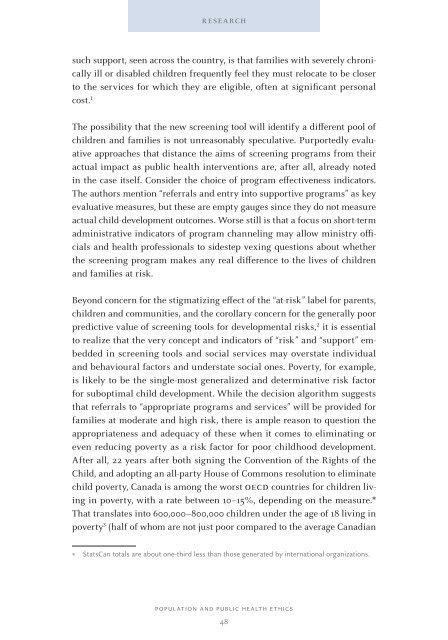PoPulationand Public HealtH etHics
PoPulationand Public HealtH etHics
PoPulationand Public HealtH etHics
Create successful ePaper yourself
Turn your PDF publications into a flip-book with our unique Google optimized e-Paper software.
esearch<br />
such support, seen across the country, is that families with severely chronically<br />
ill or disabled children frequently feel they must relocate to be closer<br />
to the services for which they are eligible, often at significant personal<br />
cost. 1<br />
The possibility that the new screening tool will identify a different pool of<br />
children and families is not unreasonably speculative. Purportedly evaluative<br />
approaches that distance the aims of screening programs from their<br />
actual impact as public health interventions are, after all, already noted<br />
in the case itself. Consider the choice of program effectiveness indicators.<br />
The authors mention “referrals and entry into supportive programs” as key<br />
evaluative measures, but these are empty gauges since they do not measure<br />
actual child-development outcomes. Worse still is that a focus on short-term<br />
administrative indicators of program channeling may allow ministry officials<br />
and health professionals to sidestep vexing questions about whether<br />
the screening program makes any real difference to the lives of children<br />
and families at risk.<br />
Beyond concern for the stigmatizing effect of the “at-risk” label for parents,<br />
children and communities, and the corollary concern for the generally poor<br />
predictive value of screening tools for developmental risks, 2 it is essential<br />
to realize that the very concept and indicators of “risk” and “support” embedded<br />
in screening tools and social services may overstate individual<br />
and behavioural factors and understate social ones. Poverty, for example,<br />
is likely to be the single-most generalized and determinative risk factor<br />
for suboptimal child development. While the decision algorithm suggests<br />
that referrals to “appropriate programs and services” will be provided for<br />
families at moderate and high risk, there is ample reason to question the<br />
appropriateness and adequacy of these when it comes to eliminating or<br />
even reducing poverty as a risk factor for poor childhood development.<br />
After all, 22 years after both signing the Convention of the Rights of the<br />
Child, and adopting an all-party House of Commons resolution to eliminate<br />
child poverty, Canada is among the worst oeCD countries for children living<br />
in poverty, with a rate between 10–15%, depending on the measure.*<br />
That translates into 600,000–800,000 children under the age of 18 living in<br />
poverty 3 (half of whom are not just poor compared to the average Canadian<br />
* StatsCan totals are about one-third less than those generated by international organizations.<br />
PoPulation anD <strong>Public</strong> <strong>HealtH</strong> <strong>etHics</strong><br />
48
















